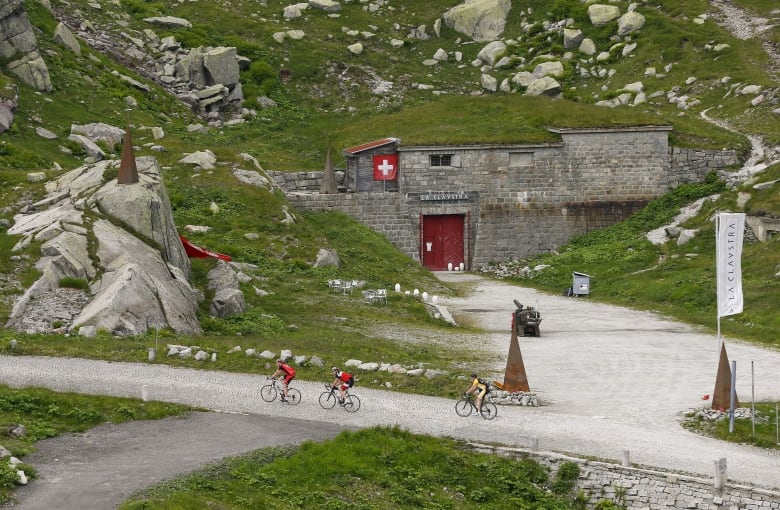In the heart of Europe lies a country known for its picturesque landscapes, precision timepieces, and delectable chocolates. Switzerland, however, harbors a less visible claim to fame, a feat of engineering and foresight unparalleled in the rest of the world. It is a claim that speaks to the nation's commitment to neutrality, peace, and the protection of its citizens. This claim is the extensive network of underground nuclear bunkers, capable of sheltering the entire Swiss population in times of extreme peril.
The concept of a bunker is not novel. Throughout history, civilizations have sought refuge underground from the ravages of war and disaster. A bunker, by definition, is a defensive military fortification designed to protect people and valued materials from falling bombs or other attacks. Typically embedded into the earth, these structures are often out of sight, reinforcing their strategic advantage. Switzerland's bunker system, however, goes a step further than most, integrating an entire nation's safety into the very fabric of its environment.

The Swiss affinity for underground fortifications is not merely a product of modernity but a culmination of a long-standing military doctrine that utilizes the natural landscape as a formidable ally. This doctrine is deeply rooted in Switzerland's non-aggressive defense strategy, which emphasizes deterrence and protection rather than offensive capabilities. The bunkers are, therefore, a natural extension of this strategy, providing a passive yet potent means of ensuring national security.
The inception of the modern Swiss bunker system can be traced back to the tumultuous years before World War I. It was during this era that Switzerland began the concerted effort to fortify its borders, anticipating the need for robust national defenses in the face of a rapidly changing geopolitical landscape. By the time World War II loomed on the horizon, the country had already laid a considerable groundwork for its bunker system.
The interwar years and the advent of World War II saw a significant expansion of the Swiss bunker network. Under the watchful eye of General Henri Guisan, Switzerland underwent a military transformation. Guisan, perceiving the growing threat of war, spearheaded the construction of numerous bunkers, particularly within the impregnable Swiss Alps. These fortifications were designed not only to shield the civilian population but also to serve as military strongholds, capable of sustaining Swiss forces during prolonged conflict.
By the war's end in 1945, Switzerland's investment in its bunkers was colossal, reportedly exceeding 10 billion dollars—an astronomical sum for the period. However, the Swiss government did not rest on its laurels. With the dawn of the atomic age and the ensuing Cold War, Switzerland's strategic focus shifted to the burgeoning threat of nuclear warfare.
In 1963, the Swiss government took a decisive step. It mandated that the nation's bunkers be expanded to ensure that every single Swiss citizen could be accommodated in the event of a nuclear cataclysm. Thus, Switzerland emerged as the sole country on the globe with the capability to protect its entire populace underground. Moreover, the system was designed with such capacity that there remained surplus space even after accounting for every citizen.
By the mid-1990s, the statistics relating to Switzerland's defensive infrastructure were staggering. The Department of Defense, Sports, and Protection of the Population (DDPS) had become the largest real estate owner in Switzerland, with over 20,000 defense objects and 11,000 buildings under its purview. The sheer number of bunkers dotted across the Swiss terrain is a testament to the scale of this endeavor, with thousands of bunkers strategically dispersed throughout the nation.
Despite their secretive nature, Switzerland has, on occasion, opened some of these bunkers to the public, offering a glimpse into this underground world. One such facility, known as K20, is reserved exclusively for the Swiss government and can be found near the city of Kandersteg. These tours provide a rare insight into the preparations a nation has made to safeguard its people against the unthinkable.
Interestingly, the anticipated disasters that justified the construction of these bunkers have, thankfully, not materialized. This has led to a unique phase of demilitarization and repurposing. With the decrease in perceived threat levels, some bunkers have transitioned from military assets to peacetime roles. Today, you might find a former bunker serving as a data center, a cheese factory, or even a quirky underground hotel.
The transformation of these bunkers is not merely a matter of commercial enterprise. It is a reflection of Switzerland's adaptive approach to its historical infrastructure. While the bunkers stand ready to serve their primary purpose if required, their peacetime applications are emblematic of a nation that values utility and pragmatism.
To understand the depth of Switzerland's commitment to its bunkers, one must delve into the specifics of their construction. The bunkers are marvels of engineering, built to withstand direct hits from bombs and equipped with life-sustaining systems. Air filtration, water purification, and waste disposal systems ensure that, in the event of a siege, life can continue beneath the surface for extended periods. The bunkers are also fitted with communication lines that remain secure and operational even under the most extreme conditions. This redundancy in design is no accident; it is a reflection of the Swiss emphasis on thoroughness and meticulous planning.
The psychology behind the bunkers also merits consideration. The knowledge that one's country has taken such extensive measures to ensure the safety of its citizens provides a sense of security that permeates Swiss society. This sense of collective protection is integral to the nation's identity and contributes to the high level of trust the Swiss place in their government and military institutions.
Looking ahead, the role of Switzerland's bunkers in the 21st century remains a subject of debate. In a world where warfare has become increasingly asymmetric and the threats more diverse, the question arises: how will these bastions of the Cold War era adapt? Climate change, for example, presents a new set of challenges that may require the bunkers to serve in capacities not originally envisioned.
Moreover, as Switzerland continues to innovate and look toward the future, the strategic value of these bunkers is being reassessed. The notion of utilizing these spaces for digital infrastructure, research facilities, or even as secure archives for global data is being explored. In this context, the bunkers may yet find a new lease on life, transitioning from their wartime legacy to become cornerstones of a globally interconnected and technologically advanced Switzerland.
The Swiss model of comprehensive underground bunkers stands as a unique solution to the age-old problem of national defense. It embodies a blend of foresight, engineering prowess, and a deep-seated desire for peace and preparedness. As Switzerland continues to navigate the challenges of the modern world, its bunkers remain a symbol of the country's resilience and its unwavering commitment to safeguarding the Swiss way of life.




